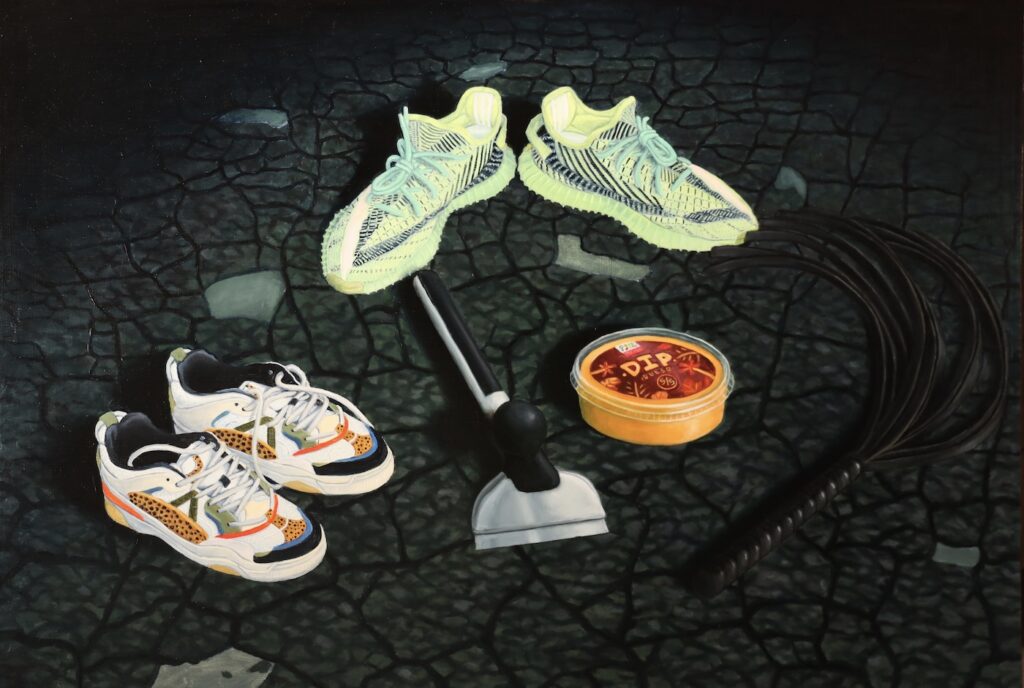CULT Aimee Friberg, San Francisco, United States
17 Oct 2020 - 05 Dec 2020

Troy Chew, Ghost Rider, 2020. Oil on Canvas24 x 36 inches.
CULT Aimee Friberg Exhibitions announces Yadadamean, a solo exhibition of oil paintings by artist Troy Chew. The show is on view from October 17 to December 5, 2020 and an artist reception with timed entry will be held on October 17 from 1 to 5 p.m. Yadadamean marks Chew’s first solo exhibition withthe gallery.
Chocolate cake, vanilla ice cream and Coca Colapresented together on a tabletop easily recallsa setup for celebration. Troy Chew’s portrayal of this assortment of delicacies, titled Yay Area,however, is a coded play on the lexicon of Hip Hop, slang terminology and Bay Area culture.Chew arranges the objects akin to scenes in Flemish still life paintings. By repurposing everydayitems from the African Diaspora into fine art compositions, Chew’s paintings embody a smoothdetachment from European painting traditions.
Yadadamean is a continuation of Chew’s Slanguage series—a reference to the colloquial speechrooted in Black linguistics. Yadadamean, a more efficient term for, “You know what I mean?”presents an assortment of terms and imagery born in the ‘Yay Area’, or Bay Area for thenon-locals’ iteration. Chew’s still lifes provoke viewers to reflect on the historical exclusion ofBlackness in Western art, despite the multitudinous facets of Black culture that have shapedmainstream aesthetics, culture and vernacular. The works recall the genesis and evolution of HipHop—created in the 1970s in South Bronx by youth who were excluded from the mainstream, itwas a rebuttal to a system of social and economic inequality. Hip Hop, and countless other formsof Black creation, existed as incubation spaces for the sharing of stories and forming of Blackcommunities.
Chew regroups the nuance of Black expression from Hip Hop, specifically Bay Area Hip Hop, andinvestigates the language used to speak about money, cars, women and drugs. Beforemainstream acceptance, slang and weed were linked to the Black community as means ofvilification and typecasting. Chew incorporates this slang, often criticized as ‘broken English,’ intohis paintings through short and sometimes nondescript titles. By combining “high’’ browcomposition with pop culture imagery—such as broccoli, a basketball, Girl Scout Cookies andYeezys—Chew elevates and embraces these everyday objects and works to reverse thestereotypes associated with them.
In Yay Area, an assemblage of party novelties is strewn on a reflective glass surface. In GhostRider, another assortment rests on asphalt. These surfaces parallel the ones found in Flemish stilllifes, where tabletops existed as scenes of performance—themes of excess, gluttony, carnage and feasting commingled here with heaps of a timeless dietary temptation, bread. This trope isexpanded in Ball Street Journal where loaves of bread lie next to cabbage, basketballs andpaper.
Flemish still lifes were also replete with memento mori—reminders of death and decay. Likewise,Chew’s paintings allude to the mortality of language. The originators of Hip Hop developed aspecific language to communicate shared experiences amongst others in their community.Language formed nurturing spaces; slang repurposed bread as the hustle for money while tooutsiders bread remained a mealtime accessory. Yaddamean challenges this ongoingerasure—the proliferation and sometimes co-opting of language—with skillful iconography thatrecreates a safe space for language and culture.
Troy Chew is a California born and raised artist whose work explores the African Diaspora withinurban culture. Recent solo exhibitions include Cushion Works and Guerrero Gallery in SanFrancisco and Parker Gallery, Los Angeles. Recent group exhibitions include California Winter,organized in collaboration with Hannah Hoffman at Kristina Kite Gallery, Los Angeles; VanguardRevisited at San Francisco Art Institute; and Black Now(here), which exhibited at the Museum ofthe African Diaspora, San Francisco and Good Mother Gallery, Oakland. Chew was a GraduateFellow Artist in Residence at the Headlands in 2018 and the Tournesol Award winner in2019-2020. He has a Bachelor’s in Psychology from the University of California, Merced and aMaster of Fine Arts from California College of the Arts – San Francisco. Chew lives and works inthe San Francisco Bay Area.
CULT Aimee Friberg
1217 B Fell St
San Francisco, CA 94117